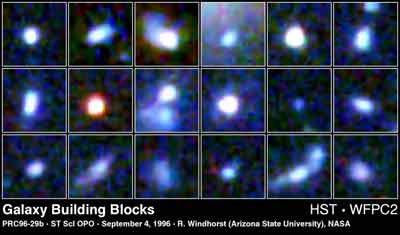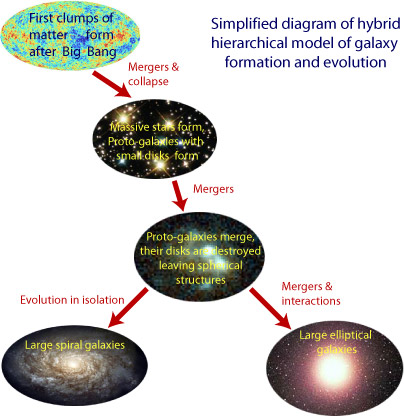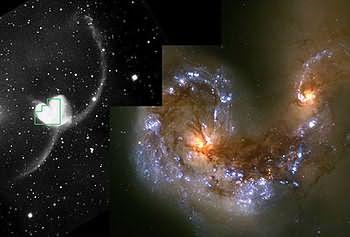The Formation of Galaxies
Galaxies
Galaxies are vast groupings of billions of stars and other material gravitationally bound together. They tend to be found in clusters of dozens to a few hundred members. Different types of galaxies include spiral galaxies such as our own Milky Way, rich in dust and gas with stars still forming in their arms; elliptical galaxies devoid of gas, lenticular galaxies and irregular galaxies such our neighbours the Magellanic Clouds and the Sagittarius dwarf galaxy.

Astronomers have do not yet have a complete understanding of how galaxies formed. We know that they formed early in the history of the Universe and recent deep observations by telescopes such as the HST at optical wavelengths and ATCA at radio wavelengths show evidence of galactic evolution over time.

A Model of Galaxy Formation
We do not yet have a definitive model of how galaxies form. Indeed this is a lively and active area of debate among astrophysicists. One of the many problems they face in trying to construct a useful model is the need to match observations of galaxies in the current or nearby Universe with those and those in the early Universe with theoretical simulations. Recent work on the role of dark matter in the early Universe has led to the hierarchical or bottom-up model gaining wide acceptance.
In the bottom-up model, the Universe contains cold dark matter (CDM). The "cold" in this case refers to the average speed of the dark matter particles, they are relatively slow compared to the speed of light. As yet This CDM results in very slight differences in the density of the primordial Universe. These irregularities can be seen as anisotropies in the cosmic microwave background radiation (CMBR) as measured by the WMAP satellite and other instruments. As the Universe expands these slight irregularities and the resultant gravitational instabilities cause gas clouds to collapse, forming extremely high-mass stars. These are thought to be among the first structures to form after the decoupling era. Gravity therefore plays the dominant role in galaxy formation.

These massive stars in turn form clusters of stars and gas some 106 × the mass of our Sun. These proto-galactic structures then interact and merge into larger structures now known as galaxies. Present-day galaxies typically have masses of 1011 solar masses so must have undergone numerous mergers. Interactions and mergers between early galaxies also caused higher rates of star formation than we now observe in most nearby galaxies.
Where galaxy interactions are common successive mergers are thought to mop up gas not bound in stars and smooth the shape. Large elliptical galaxies are the result. Examples of these in the nearby Universe show little or no free gas and low rates or no star formation.
If a galaxy evolves in relative isolation with few interactions then a spiral galaxy is likely to be the result. these still have gas in their spiral arms. We can observe star formation still taking place in the arms of spirals.

The model described in this section is only one possibility and there are still many questions to be answered. As our technology improves we should be able to make further observations of the early Universe and also produce more realistic computer simulations. When combined these may enlighten us more as to how galaxies form and evolve.
